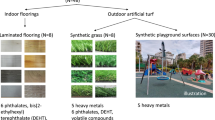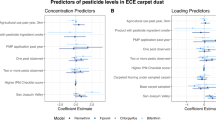Abstract
Choosing the appropriate floor surface for a school environment is a complex issue. To assist school personnel in determining which flooring is best for their school, we studied the biocontaminant levels associated with carpeted and hard surface flooring. Two schools were selected, one predominantly tiled and one predominantly carpeted, as similar as possible with the exception of their floor coverings. Neither school was a “problem” building. Multiple biocontaminants were measured. For flooring, there were statistically significant differences for all the tested biocontaminants except fungi. The carpeted surfaces, being strong sinks, generally had higher surface loadings of the biocontaminants, while the airborne levels were significantly higher over tiled floors. Significant differences in airborne levels were found for dust mass, spores, fungi, β-1,3 glucans, and endotoxins. The results suggest that carpet flooring was not the major contributor to airborne levels of biocontaminants in these two nonproblem schools.
This is a preview of subscription content, access via your institution
Access options
Subscribe to this journal
Receive 6 print issues and online access
$259.00 per year
only $43.17 per issue
Buy this article
- Purchase on Springer Link
- Instant access to full article PDF
Prices may be subject to local taxes which are calculated during checkout
Similar content being viewed by others
Notes
SAS is the registered trademark of SAS Institute, Inc., Cary, NC, USA.
References
ASTM D 5438. Standard Practice for Collection of Dust from Carpeted Floors for Chemical Analyses, American Society of Testing and Materials, West Conshohocken, PA, USA, 2000.
Beijer L., Thorn J., and Rylander R. Inhalation of (1,3)-β-D-glucan in humans. In: Johanning E. (Ed.). Bioaerosols, Fungi and Mycotoxins: Health Effect, Assessment, Prevention and Control. Eastern New York Occupational and Environmental Health Center, Albany, NY, USA, 1999.
Beijer L., Thorn J,, and Rylander R. Effects after inhalation of (1,3)-β-D-glucan and relation to mould exposure in the home. Mediators Inflamm 2002: 11: 149–153.
Daisey J., Angell W., and Apte M. Indoor air quality, ventilation and health symptoms in schools: an analysis of existing information. Indoor Air 2003: 13: 53–64.
Dharmage S., Bailey M., Raven J., Abeyawickrama K., Cao D., Guest D., Rolland J., Forbes A., Thein F., Abramson M., and Walters E. Mouldy houses influence symptoms of asthma among atopic individuals. Clin. Exp. Allergy. 2002: 32: 714–720.
Food and Drug Administration, Center for Biologics Evaluation and Research. Methods of the Allergenics Products Testing Laboratory, [Docket No. 94N-0012]. Fed Reg 1994: 59(225): 60362–60363.
Franke D.L., Cole E.C., Leese K.E., Foarde K.K., and Berry M.A. Cleaning for improved indoor air quality: an initial assessment of effectiveness. Indoor Air 1997: 7: 41–54.
Hamilton R., Chapman M., Platts-Mills T., and Adlkinson Jr N. House dust aeroallergen measurements in clinical practice a guide to allergen-free home and work environments. Immunol Allergy Practice 1992: 14: 9–25.
Hinds W.C. Aerosol Technology: Properties, Behavior, and Measurement of Airborne Particles. John Wiley, New York, 1982.
Leese K.E., et al. Using a High-volume, small surface sampler (HVS3) for the microbiological evaluation of dust from carpeted and non-carpeted surfaces. Proceedings of the AWMA Measurement of Toxic and Related Air Pollutants Conference, Durham, NC, 1993: pp. 82–87.
Park J., Spiegelman D., Burge H., Gold D., Chew G., and Milton D. Longitudinal study of dust and airborne endotoxin in the home. Environ Health Pers 2000: 108(11): 1023–1028.
Price J., Pollock I., Little S., Longbotton J., and Warner J. Measurement of airborne mite antigen in homes of asthmatic children. Lancet 1990: 336: 895–897.
Rand T. An assessment of mold contamination problems in Atlantic Canada Schools: mold burdens, amplifying sites and benefits of proactive school inspection policies. In: Johanning E (ed.) Bioaerosols, Fungi and Mycotoxins: Health Effect, Assessment, Prevention and Control. Eastern New York Occupational and Environmental Health Center, Albany, NY, USA, 1999.
Roberts J.W., et al. A small high volume surface sampler HVS3 for pesticides and other toxic substances in house dust. 84th Annual Meeting, Air and Waste Management Association, Vancouver, BC, June 16–21, Paper No. 91–150.2, 1991.
Ronborg S., Mosbech H., and Poulsen L. Exposure chamber for allergen challenge. A placebo-controlled, double-blind trial in house-dust-mite asthma. Allergy 1997: 52: 821–828.
Trakumas S., Willeke K., Reponen T., and Trunov M. Final report particle cut-size evaluation of Air-O-Cell sampler. http://www.zefon.com/analytical/download/cutsize.pdf, 1998.
Vincent J.H. Aerosol Science for Industrial Hygienists. Elsevier Science, Ltd, New York, 1995.
Willis R.D. “SEM Characterization of House Dusts Collected by Conventional Vacuum and The HVS3 Sampler.” Report to the USEPA under Contract 68-D5-0049. ManTech Environmental Technology, Inc., Research Triangle Park, NC, USA, 1995.
Acknowledgements
We greatly appreciate the technical assistance of Tricia D Webber and Michael L Herman of RTI in collecting the data, C. Andrew Clayton, RTI statistician, for the statistical analysis and the Harnett County, NC School System for participating in the project. We would also like to thank Dr. Douglas VanOsdell for developing the school profile and Dr. Philip Lawless for his assistance in the interpretation of the data. This project was funded by the Carpet and Rug Institute.
Author information
Authors and Affiliations
Corresponding author
Rights and permissions
About this article
Cite this article
Foarde, K., Berry, M. Comparison of biocontaminant levels associated with hard vs. carpet floors in nonproblem schools: Results of a year long study. J Expo Sci Environ Epidemiol 14 (Suppl 1), S41–S48 (2004). https://doi.org/10.1038/sj.jea.7500357
Published:
Issue Date:
DOI: https://doi.org/10.1038/sj.jea.7500357
Keywords
This article is cited by
-
Antifungal and Antibacterial Activity of Terpenes for Improvement of Indoor Air Quality
Current Fungal Infection Reports (2020)
-
(1 → 3)-β-d-glucan in different background environments and seasons
Aerobiologia (2011)



